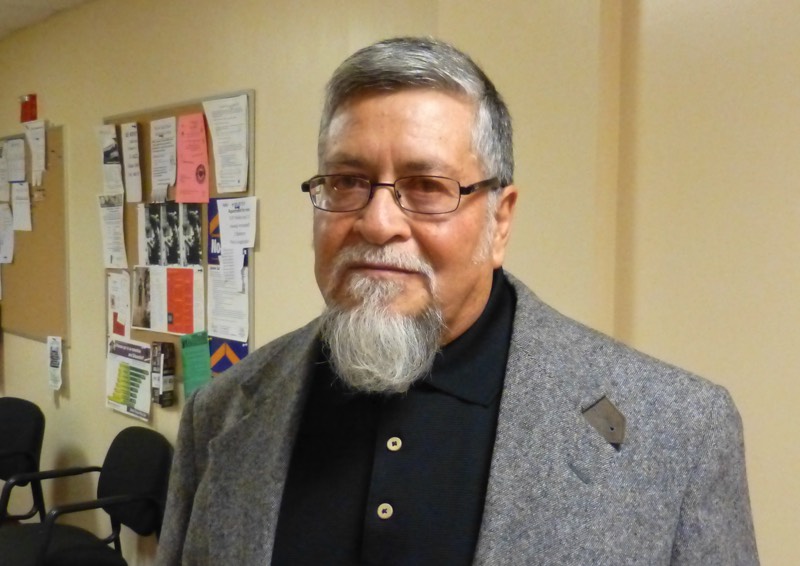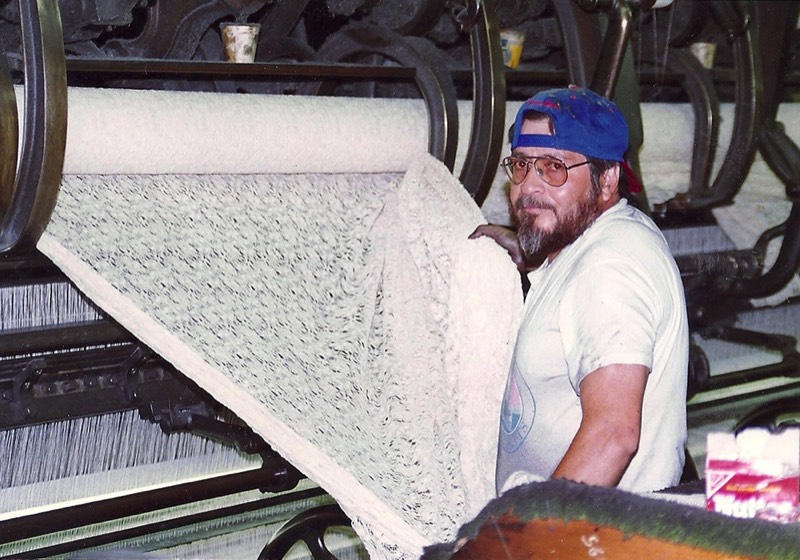Mexicans in Rhode Island ... continued.


Gilberto Garcia, working at Rhode Island Lace Works in the 1980s. Slide your cursor over the photo and see Gilberto in 2013.
The 1980s and then NAFTA
Since the turn of the century, textile production has played an important role in the gross domestic product of Mexico. Textile production includes the making of thread, cloth and decoration, in both natural and synthetic fibers. From the end of the Mexican Revolution to the mid-2000s, the textile production, and particularly lacework, saw steady growth. Much of the growth in the last four decades was spearheaded by “maquiladoras” or manufacturing plants along the northern border.
Mexico gained advantages in the lacemaking and textile market in the 1990s when the U.S. signed the North American Free Trade Agreement (NAFTA). In 2004, all restrictions and quotas on Mexican textiles were lifted in the United States. Unfortunately for Rhode Island, it was then that much of the local textile and lacemaking industry began to fold when local factories moved to border cities in Texas and California.
Mexico gained advantages in the lacemaking and textile market in the 1990s when the U.S. signed the North American Free Trade Agreement (NAFTA). In 2004, all restrictions and quotas on Mexican textiles were lifted in the United States. Unfortunately for Rhode Island, it was then that much of the local textile and lacemaking industry began to fold when local factories moved to border cities in Texas and California.
Rhode Island Laceworks
Forty-year-old Gilberto García was born in Nicolás Romero, México and was living in Nacaulpan, México when he moved to Rhode Island in October of 1987.
He was recruited by fellow Mexican, Roberto Calzada, who was working for the Rhode Island Lace Works in Barrington, RI. Calzada was sent to Naucalpan to recruit workers who were skilled in using new lace machinery that had recently been acquired by Rhode Island Lace Works. Gilberto had been a lace worker for 27-years in Naucalpan and was very skilled, so he decided to come to Rhode Island to lend a hand. His plan was to stay four years and then return to México.
When he arrived in Rhode Island, he was connected with four other Mexicans who had also arrived the previous day. According to García, they lived together in a “very large apartment” in Warren, RI.
Gilberto said that when he first arrived, he was amazed at what he saw in Rhode Island – especially how clean and “nice” it was here, compared to what he was used to in Mexico. He often tried to go out and explore, but could not get any of his companions/ roommates to go with him; they preferred to stay home, watch television and were generally afraid or uncomfortable venturing because of language barrier and cultural insecurities. Gilberto said that they told him that they did not want to be hassled, so they kept to themselves. And of course, there was the weather, which neither of the Mexicans were accustomed to, and which added to the reasons why they stayed indoors most of the time. Gilberto, however, did not let any of that stop him, and he often made an effort to go into Providence to explore his temporary home. During these adventures around Rhode Island, he also started to learn some English and began to like living here.
He was recruited by fellow Mexican, Roberto Calzada, who was working for the Rhode Island Lace Works in Barrington, RI. Calzada was sent to Naucalpan to recruit workers who were skilled in using new lace machinery that had recently been acquired by Rhode Island Lace Works. Gilberto had been a lace worker for 27-years in Naucalpan and was very skilled, so he decided to come to Rhode Island to lend a hand. His plan was to stay four years and then return to México.
When he arrived in Rhode Island, he was connected with four other Mexicans who had also arrived the previous day. According to García, they lived together in a “very large apartment” in Warren, RI.
Gilberto said that when he first arrived, he was amazed at what he saw in Rhode Island – especially how clean and “nice” it was here, compared to what he was used to in Mexico. He often tried to go out and explore, but could not get any of his companions/ roommates to go with him; they preferred to stay home, watch television and were generally afraid or uncomfortable venturing because of language barrier and cultural insecurities. Gilberto said that they told him that they did not want to be hassled, so they kept to themselves. And of course, there was the weather, which neither of the Mexicans were accustomed to, and which added to the reasons why they stayed indoors most of the time. Gilberto, however, did not let any of that stop him, and he often made an effort to go into Providence to explore his temporary home. During these adventures around Rhode Island, he also started to learn some English and began to like living here.
After four years [in 1991], Rhode Island Lace Works closed. Gilberto prolonged his stay in Rhode Island when he and his companions were sent to work at Seekonk Lace in Seekonk, MA. They also worked at the Rhode Island factory of Seekonk Lace in Pawtucket. By the end of the year, Gilberto went to work at Frontier Lace [now Frontier Manufacturing] on Hopkins Hill in Coventry, RI. After that, he went to work in Perkins Lace in North Kingstown [Quonset]
“In those days, the lace business in RI was a thriving business,” said Gilberto. But soon all the factories went out of business when machinery was updated and they became what García referred to as “electronic.” It was then that workers were no longer needed to run the old machinery and the lace business changed, and unfortunately for workers like Gilberto, factories began to close.
What also effected this change, added Gilberto, was the signing of the North American Free Trade Act (NAFTA), which eventually closed the textile and lacemaking industry in Rhode Island and this type of work was sent to U.S. border cities where Maquiladora workers produced the work for less money.
Eventually, Gilberto left the lace business and decided to stay in Rhode Island: he took ESL classes at Progreso Latino in Central Falls, became a Certified Nurses Assistant (CNA), and eventually married. Today, he still lives in Barrington.
As for his Mexican companions, Gilberto says he lost track of them and does not know where they ended up. “I suspect some went home because I remember how homesick they were,” said Gilberto. ◼︎
“In those days, the lace business in RI was a thriving business,” said Gilberto. But soon all the factories went out of business when machinery was updated and they became what García referred to as “electronic.” It was then that workers were no longer needed to run the old machinery and the lace business changed, and unfortunately for workers like Gilberto, factories began to close.
What also effected this change, added Gilberto, was the signing of the North American Free Trade Act (NAFTA), which eventually closed the textile and lacemaking industry in Rhode Island and this type of work was sent to U.S. border cities where Maquiladora workers produced the work for less money.
Eventually, Gilberto left the lace business and decided to stay in Rhode Island: he took ESL classes at Progreso Latino in Central Falls, became a Certified Nurses Assistant (CNA), and eventually married. Today, he still lives in Barrington.
As for his Mexican companions, Gilberto says he lost track of them and does not know where they ended up. “I suspect some went home because I remember how homesick they were,” said Gilberto. ◼︎

© All Rights Reserved | Nuestras Raíces: Latino History of RI © | When using materials from this website, please acknowledge by stating the name of the URL of the webpage on which it is displayed. Citations should include full bibliographic information as follows: Courtesy of the Latino Oral History Project of Rhode Island, Central Falls, RI.
